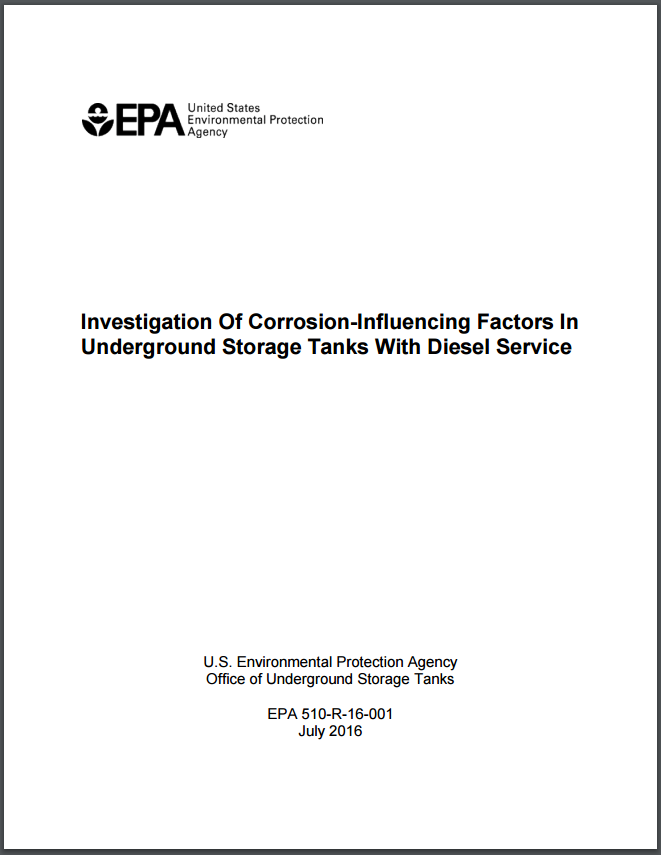Corrosion in Diesel Fuel Storage Tanks - The Results
Back in 2017, Bell Performance did a webinar on an important issue that we thought was important to share it with our blog readers: corrosion in...
5 min read
Erik Bjornstad : Mar 16 2017

Back in 2017, Bell Performance held a webinar on an important issue that we thought was important to share with our blog readers. Throughout 4 articles, we will be sharing the content of that webinar here on the blog.
Welcome to Bell Performance’s first webinar of 2017. I am Erik Bjornstad and I’m the technical information director here at Bell Performance in Central Florida.
This is not the first webinar we've ever done; our past topics have focused on fuel-related topics like how diesel fuel has changed over the years, and the effects of biofuels like ethanol and biodiesel on our nation’s fuel supply.
For this one, we want to talk about a problem that affects anyone and everyone who either stores fuel or relies on stored fuel to accomplish essential business and emergency tasks in their business. And that is the problem of storage tank corrosion. We want to talk about a report published in July 2016 by the EPA, summarizing their comprehensive research study on underground storage tank systems storing diesel fuel.
We’ll break this up into four main points:
First, we’ll talk about some significant events from the last decade that have brought us (the collective us) to the point where the EPA determined that such a study was needed.
Then we’ll look at what they did – what they looked at, and what they were trying to find.
Of course, once you do that, you have to look at the results – what did the EPA find?
Last, we’ll break down the EPA’s recommendations for the industry – the best practices the EPA recommends that were informed by the results of what they found.
In their study, they (the EPA) had three primary aims:
To get some perspective, we can start by acknowledging just how many tanks there are out there that potentially may be covered by this study’s findings. There are at least 100,000 federally regulated USTs storing diesel fuel. This does not include aboveground stored tanks, nor does it include smaller unregulated tanks on farms or ones with home heating oil. So, there’s an awful lot of stored fuel out there in a lot of fuel storage tanks. And a lot of these tanks are quite old. The older the tank, the greater likelihood there is of a problem developing. These possibilities matter because this issue is the kind of situation where the consequences of such a problem developing aren’t exactly minor.
To get a proper understanding of the problem and why the EPA felt it important to do what they did, we first have to understand the history of the issue.
Fuel has been stored in storage tanks ever since fuel has been around. It’s not like storage tanks were only invented 20-30 years ago. But to look at instances of corrosion in storage tanks, we have to start back in 2007.
2007 was the first known report of corrosion on internal metal components in vapor space, a report posted on the Petroleum Equipment Institute (PEI) website. The intial such reports were concentrated in the upper portion of UST systems – in other words, regions not generally submerged in the fuel.
Prior to 2007, storage tank corrosion was considered a minor problem that occurred only in the wetted (lower) portion of the tank. With these new reports, now there’s a new and troubling trend that the industry is starting to see.
Something else that emerged was the notable trend that the corrosion observed since 2007 was happening to tank owners who continued to follow the same maintenance practices they had done for years without any previous corrosion issues.
Now jump to 2010.
In 2010 PEI did a five-question survey for tank owners, operators, and technicians, asking them about what they’ve been observing with respect to instances of corrosion and damage in their storage tanks. The results enabled PEI to compile a list of UST equipment that was most commonly affected by corrosion. The results also suggested that all metals either in contact with fuel or exposed to vapors could potentially be affected by corrosion.
So now, with these results, momentum in the industry starts to gather along with an increased urgency to find solutions to this issue. It’s now been four years or so since the problem first emerged to any noticeable level. The industry is starting to realize that this problem isn’t slowing down, it’s getting worse.
Jump now to 2012 when another industry group starts getting involved – the CDFA or Clean Diesel Fuel Alliance.
The CDFA is a collaborative group between government and private industry, and between 2010 and 2012, they complete and then publish the first major field study on tank corrosion. Given the state of the market at that time, it seems surprising that, to that point, nobody had executed the kind of rigorous and controlled examination of storage tank systems that would yield valid information on problems like this. But that’s the way it was.
In their study, the CDFA examined six operating UST systems. From the study resnults, they concluded that metal corrosion in storage tanks was caused by the presence of low MW acids (i.e. acetic and formic acid) in the system. They further concluded that these acids were produced as metabolic byproducts of microbes.
Once it’s hypothesized that microbes are a causative agent here, the question follows of what was contributing or enabling these microbes to thrive. Microbes have been around for years, so why now are they causing these problems? Though there’s probably not only one single answer, the CDFA suggested that some recent changes to the fuel supply might be strongly associated.
This was where the theory about ethanol switch-loading came from, due to the study’s finding of ethanol presence in some of the fuel and their associated water bottom samples. The microbes produce acetic acid, which volatilizes into the vapor space, causing corrosion.
CDFA also suggested other things going on, including something as seemingly minor as trace amounts of glycerol remaining from biodiesel production. Metabolic consumption of glycerol by microbes led to lactic, glyceric, and propionic acids being produced, all of which can be volatile.
Given all of that, there seemed to be multiple possibilities as to why. So, the EPA decided it needed to undertake some research to look at this issue further, because of the possibility of environmental and human health effects that are potentially serious enough that the EPA felt they could not be ignored. Meanwhile, the CRC (Coordinating Research Council) was another industry group that had already been planning to do such an additional research study. The EPA decided to collaborate with them to make sure that efforts weren’t duplicated.
It was decided that the best approach was to do field research on a larger population of tanks while looking for predictive factors that might help everyone better understand this obvious problem.
So, these were the milestones that brought us to where we’re at today. There seems to be a problem that warrants some serious research. The next question we need to consider concerns the people with the potential to be the most seriously affected by these problems – the storage tank owners and operators. These parties have a vested interest in this research because of what might happen to them should these problems become manifested where they are at.
What are the potential consequences or problems of storage tank corrosion? When you look more closely, some of these problems appear to be pretty painful and pretty serious. We can start with a relative minor one - Plugging of dispenser filters with corrosion debris (that resembles coffee grounds), so they have to be changed more often.
Corrosion in the upper vapor spaces can cause equipment failure by preventing the proper operation of release detection and prevention equipment.
Lack of proper functioning of various release prevention equipment (required in all tanks)
Risk to tank integrity, especially in the bottom of metal tanks. Corrosion of metal tank walls or metal bungs in fiberglass tanks, which could cause a release of fuel into the environment
Liability risk for tank owners who are responsible for clean-up costs if this occurs
This issue is and should be important to tank owners. So, the EPA started implementing a research plan to look into the matter in ways that surpassed what had previously been done.
Click here to read the second part of the webinar transcript: Corrosion in Diesel Fuel Storage Tanks- The EPA’s Methodology.
Back in 2017, Bell Performance did a webinar on an important issue that we thought was important to share it with our blog readers: corrosion in...

The first Bell Performance webinar of 2017 dealt with such an important issue that we thought it was important to share it with our blog readers....

There are over 100,000 diesel fuel storage tanks across the United States, all of them holding diesel fuel that could be many years old. Over the...